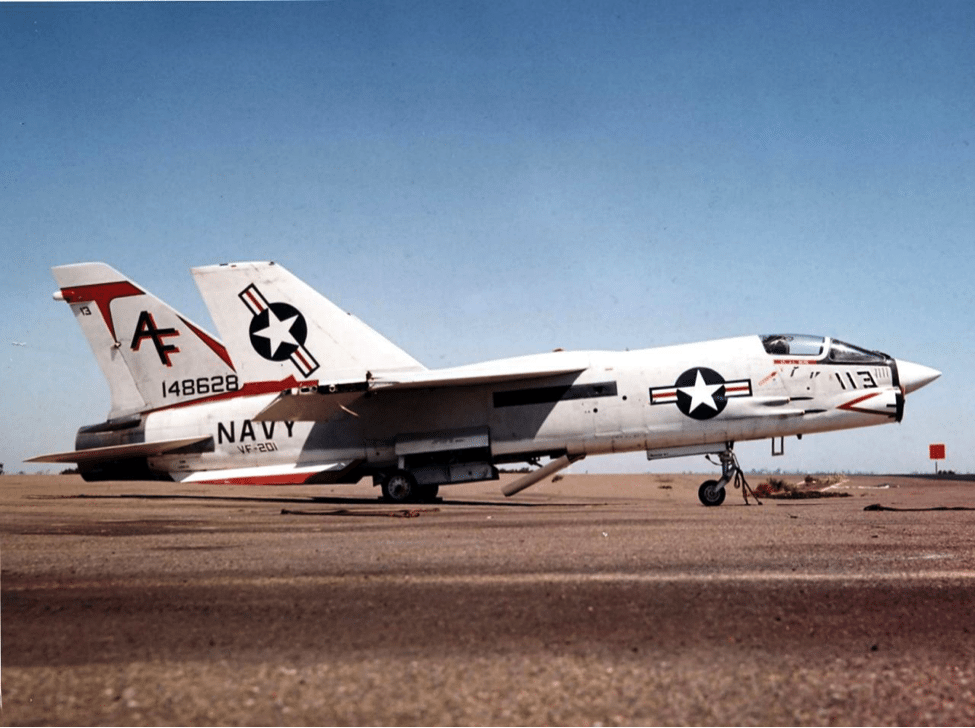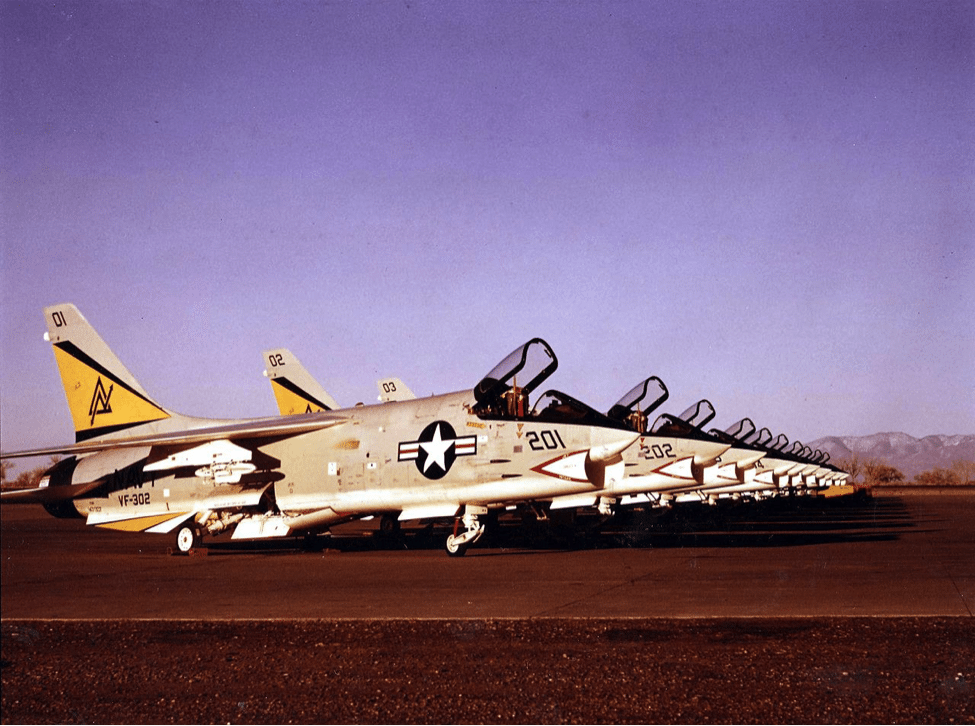Operational Considerations
F-8s operated from all of the carrier classes (Essex, Midway, and Forrestal) conducting operations off Vietnam, although they primarily flew from the smaller deck Essex-class carriers. Phantoms were restricted to the Midway and Forrestal classes only. The compositions of many carrier air wings were adjusted to include both Crusaders and Phantoms in their makeup early in the war.

The MiG Master
While Crusaders were billed as gunfighters, they only achieved four confirmed kills in Vietnam using only their 20 millimeter cannon. High-G loads during air combat maneuvering (ACM) could and did cause the cannon feed mechanisms to jam, forcing the Crusaders to fire their AIM-9 Sidewinder missiles. F-8s also scored kills with Zuni unguided rockets. One kill was notched when a North Vietnamese pilot chose to eject from his MiG-17 rather than take on a VF-211 Crusader pilot. Although the F-8s achieved a 19 to 3 kill ratio (the best of any American aircraft) against the North Vietnamese MiGs, 170 Crusaders were lost during the war (to all causes).

Keeping Them Flying
There were five primary variants of the Crusader and several other variants that were major rebuild/upgrade programs of previously manufactured aircraft. Vought delivered the last of the 1,219 Crusaders built for the United States forces to VF-124, based at NAS Miramar in California, on 3 September 1964. This F-8 would be one of the airframes used by the fledgling TOPGUN command at Miramar. After nearly two decades of service the last operational Crusader fighter squadrons to switch to F-4 Phantom IIs were VF-191 Satan’s Kittens and VF-194 Red Lightning. They were deployed as part of CVW-19 aboard USS Oriskany (CVA-34) for her final WestPac deployment ending in March of 1976.

Not Done Just Yet
Navy Reserve fighter squadrons all over the country began using early F-8A and F-8B Crusaders in 1965. Many of these weary F-8s were hangar queens and were not fully operational- and in some cases dangerous. When the North Koreans seized the intelligence ship USS Pueblo (AGER-2) in 1968 several reserve squadrons were mobilized and it became obvious that the reserve Crusaders just weren’t up to the task. CDR Jack D. Woodul, also known as Youthly Puresome, described his time flying Crusaders in the reserves in an exclusive interview with Avgeekery.com, which you can enjoy right here.

Building Better Reserves
The result of the Pueblo callups was a major reorganization of the reserves beginning in July of 1970. Two reserve carrier air wings (CVWRs) were created. CVWR-20 became an Atlantic Fleet asset and CVWR-30 became part of the Pacific Fleet. Each CVWR was made up of eight squadrons–two fighter squadrons, three attack squadrons, one early warning squadron, one tanker squadron, and one light photo squadron. Eventually an electronic attack squadron was added to each CVWR as well.

The Last and the Best Crusaders
Beginning in 1970 newer and more reliable Crusaders equipped three of the squadrons in each CVWR- both fighter squadrons and the light photo squadron. VF-201 Hunters and VF-202 Superheats, based at NAS Dallas in Texas, were part of CVWR-20. VF-301 Devil’s Disciples and VF-302 Stallions, based at NAS Miramar in California, were part of CVWR-30. All four reserve fighter squadrons flew the F-8H and later the F-8J. Light photographic squadrons VFP-206 Hawkeyes and VFP-306 Peeping Toms were based at Andrews Air Force Base (AFB) near Washington DC. Both squadrons flew the RF-8G variant of the Crusader.

Time at Last to Bow Out
By the time the late 1970s had rolled around the Naval and Marine reserve fighter squadrons had all transitioned to F-4Bs or F-4Js. The RF-8G photo birds continued to serve in the active light photographic squadrons and with the reserves for another ten years until replaced in most cases by RF-4B Phantoms. On 29 March 1987 the last Crusader-equipped reserve squadron (VFP-206) retired the very last operational RF-8G, after which the aircraft was handed over to the Smithsonian.

Still Serving Abroad
In addition to the United States Navy and Marines, France and the Philippines operated F-8 Crusaders. The French Crusaders were new-build F-8Es with some modification for use by the French off their small-deck carriers. Upgraded and improved throughout their service lives, the French F-8s were finally retired in 1999. The Philippines operated 35 refurbished F-8Hs between 1977 and 1988, when they were grounded. In 1991 they were badly damaged during the Mount Pinatubo eruption and scrapped.

Our Favorite ‘Sader Sea Story
In the anecdote department we have this bit of Cold War history. During the 1960s and 1970s in particular, Russian intelligence gathering ships (AGIs or “trawlers”) would mercilessly dog American carrier task groups (especially the carriers themselves) just about everywhere they operated. Often closing close aboard and forcing ships to avoid them (especially during flight ops), the AGIs were a pain in the…neck. Deciding to directly address the issue, one Crusader pilot deployed in the Mediterranean loaded several rolls of toilet paper into the lightening holes inside his aircraft’s speed brake. One low-level pass over the trawler with an open speed brake later the AGI was liberally draped with T.P. Does anyone have a picture of that AGI after the wrap job or the mission marking stenciled on the F-8 afterward?

[…] consisted of VF-14 Tophatters flying the McDonnell F3H Demon, VF-11 Red Rippers flying the Vought F-8E Crusader, VA-172 Blue Bolts and VA-12 Flying Ubangis both both equipped with the Douglas A-4C Skyhawk, […]
[…] Vought produced this retrospective film about their F8U-1 and F8U-2 Crusader fighter the days of the Last Gunfighter serving in frontline fleet squadrons were numbered. Their other […]